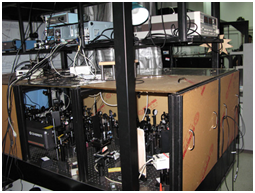TEDA Institute of Biological Sciences and Biotechnology, Nankai University
The key Laboratories:
● Key Laboratory of Molecular Microbiology and Technology of Ministry of Education
● Key Laboratory of Microbial Functional Genomics of Tianjin Government
● Engineering and Research Center for Microbial Functional Genomics and Detection Technology of Ministry of Education
● Research Center for Functional Genomics and Biochip of Tianjin municipal Government
The main fields of research consist of genomics, functional genomics, synthetic biology, microarray, bioinformatics, molecular virology and other associated subjects. The research platforms are equipped with state-of-the-art facilities, including:
Argus Genome Optical Mapping Workstation
Ion Torrent Personal Genome Machine (PGM)
Illumina Genome AnalyzerIIx
ABI 3730 DNA Sequence Analyzer
ABI 7300 Real Time PCR System
ABI 4700 Proteomics Discovery System (MALDI-TOF-TOF)
LCQ Advertage MAX LC-MS
BECKMAN P/ACE MDQ Capillary Electrophoresis System
6820 Gas Chromatography Equipment
ABI BioCAD700E Protein Purification Workstation
Bio - Rad Two-Dimensional Electrophoresis System
Biochip Spotting System PE SpotArray 72
Biochip Spotting System Bio-Dot AD5000
Biochip Scanner Genepix Personal 4100A
Bio-Plex Protein Array System
Affymetrix GeneChip® Scanner 3000 MegAllel™ 7G plus System
SUN V880 Server
Dawn EP480 Server
SGI Altix 350 Server
Bio - Rad PDQuest Software
GA-Plot Software
VirtualGenome Software

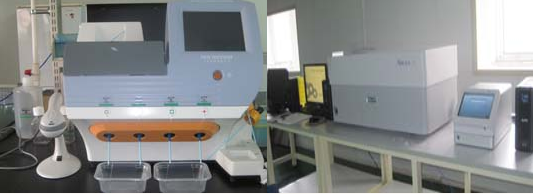
TEDA Institute of Applied Physics
1. Bio-imaging and Nanobioscience Laboratory
RESEARCH FIELDS
General Research Direction:
Study the signal transduction process on cell level by bio-imaging and nanobiotechnology.
Current Topics:
Study of mechanisms of S-nitrosylation modification-induced cytosolic calcium change in activated human neutrophils.
Pattern Formation of 3D blood vessel by vascular mesenchymal cells with micro/nano optical lithography technique.
Application of dissipative structure theory on the study the neutrophils immune response and pattern formation of vascular mesenchymal cells
Investigate of the effect of physical stimulation (magnetic field, mechanical force) on osteoblasts.
Optical super resolution imaging (beyond the Diffraction Barrier), e. g., by stimulated emission depletion fluorescence microscopy (STED) and high time-resolved fluorescent imaging by EMCCD/ICCD.
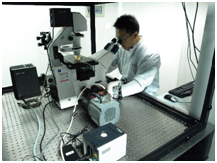
2.Electro-Optical Materials and Devices Laboratory
RESEARCH FIELDS
General Research Direction:
Multifunctional optical crystals and related applications.
Current Topics:
Nonlinear optical crystals: effects and applications.
Photorefractive and optical damage resistant crystals.
Electro-optical crystals.
Laser crystals.
Photonic microstructures.
EQUIPMENT
Crystal growth facilities; facilities for oxidation-reduction treatments, annealing, high temperature reaction, cutting, grinding, and polishing; X-ray crystal orientation facilities; laser interferometers.

3.Glass and Fiber Laboratory
RESEARCH FIELDS
General Research Direction:
Synthesis and characterization of rare-earth doped glass and optical fiber.
Current Topics:
Synthesis of glass, glass ceramic and optical fiber doped with rare-earth ions.
Spectra investigation on luminescence character of materials.
Measurement and control of the micro-structure of materials.
Enhancing luminescence by SPP.
EQUIPMENT
Vacuum evaporator, Fluorescence spectroscopy, Polishing machine, High temperature furnace.
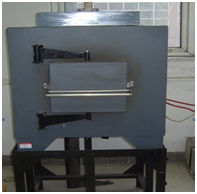
4. Low-Dimensional Functional Materials and Devices
RESEARCH FIELDS
General Research Direction:
Physical chemistry of low-dimensional functional materials.
Current Topics:
Preparation of TiO2 nanoparticles as visible-light photocatalysts; study of mechanisms of photocatalytic activity.
Preparation and photoelectric characterisation of micro/nano structural functional materials.
Ordered nanostructural composites: synthesis, properties, and functionality.
EQUIPMENT
Techcomp GC-7890F Gas Chromatography, Milli-Q Academic Utralpure Water System, COD (chemical oxygen demand) Instrument, UV-vis Spectrometer (Shimadzu), Analytical Balance (Sartorius), Rotary Evaporator, High-Speed Centrifuge, Electrochemical Workstation.
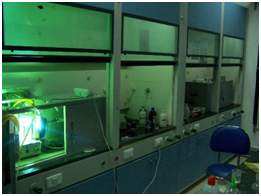
5. Microscale Photonics Laboratory
RESEARCH FIELDS
General Research Direction:
The laboratory is mainly engaged in Micro-nanooptics,Nonlinear optics research. Research areas include micro-structure, small-scale particles, a variety of micro-optical properties of nano fibers. Laboratory has undertaken a national 863, 973 plan and other multi-project research projects, with multiple large-scale test equipment.
EQUIPMENT
The main experimental equipment: Israel Nanonics near-field optical microscope, the British Renishawinvia Raman spectroscopy, Veeco SPM scanning probe microscope, Hitachi spectrophotometer, fluorescence spectrometer Edinburgh, Coherent excimer lasers.
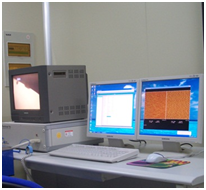
6. Molecular-Photonics and Sensor Laboratory
RESEARCH FIELDS
Current Topics:
Surface Enhanced Raman Spectroscopy (SERS)
Plasmonics and its application
Simulation of SERS by using FDTD, DDA, FEM methods
Thereasearch of the role of periodic microstructure in SERS and its application
Thereasearch of the role of colloidal metal nanoparticles in SERS and its application
Near-infrared spectroscopy (NIRS)
Thereasearch of chemometrics and spectral models
The application of NIRS
Molecular Dynamics (MD)
Thereasearch of MD potential models, Tersoff Potential……
Global Optimization Algorithms, Simulated annealing, Monte Carlo, Genetic algorithms ……
Construction of database for semiconductor, metal
Instruments and Equipments manufacturing
Advanced manufacturing technology, such as focused ion beam (FIB), lithography ……
Spectroscopy and microscopy, Open microscope, Raman spectroscopy, NIR spectroscopy ……
Detector, including InGaAs array detector, Si detector, CCD, ICCD, EMCCD ……
Micro-electro mechanical systems (MEMS), Micro-opto-electro mechanical systems (MOEMS)
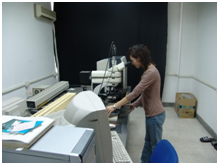
7. Nonlinear Optics Laboratory
RESEARCH FIELDS
General Research Direction:
Nonlinear Optics and Nonlinear Photonics.
Current Topics:
Excited states nonlinear absorption and refraction for organic and supramolecular materials, such as porphyrin and fullerene.
Studying on beam propagation method and applications, such as optimization of Z-scan technique and optical limiting.
Surface-enhanced Raman scattering fiber sensor.
PlasmonicMetamaterials.
Nano-optics and nano-photonics.
Utrafast optics and its applications.
EQUIPMENT
A Q-switched Nd:YAG laser (Continuum Surelite-II), a mode-locked Nd:YAG laser (Continuum Model PY61), an Argon iron laser (A-237) and a Ti:Sapphire Mode-locked Laser (Spectra-Physics), Boxcar, EPM2000, Spiricon Beam Profilers.
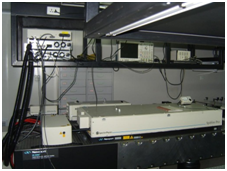
8.Novel Fluorescent Materials and Devices Laboratory
RESEARCH FIELDS
General Research Direction:
Fluorescence mechanisms and ultrafast relaxation of excited states in nanocrystals.
Current Topics:
Synthesis of nanocrystaline materials: Oxyfluoride glass ceramics doped with rare earth ions and II-VI nanocrystal particles.
Fluorescence mechanisms: Energy transfer between rare earth ions and host materials.
Femtosecond spectroscopy: Ultrafast relaxation of excited states in II-VI nanocrysal particles.
EQUIPMENT
Clean room with femtosecond system: oscillator, regeneration amplifier, and optical parametric amplifier;
Chemical synthesis room for nanocrystal fluorescence materials;
Fluorescence spectroscopy: absorption, emission, and excitation spectra.
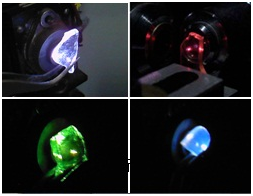
9. Quantum Photonics Lab
RESEARCH FIELDS
General Research Direction:
Nonlinear optical phenomena at low light intensity.
Current Topics:
Photorefractive materials: Effects and applications.
Optical storage: Materials, storage mechanisms, technological aspects, non-volatile storage, super-high data density, high-speed recording and data transfer.
Nonlinear dispersive systems: Dynamic properties of photon propagation and applications.
Quantum optics: Nonlinear optics of resonant media, electromagnetically induced transparency, control of light speed.
Properties and applications of so-called slow and fast light.
EQUIPMENT
Two cleanrooms, a tunable single frequency laser system (Coherent 899-29), an Argon iron laser (A-237), several He-Ne lasers, several solid state lasers (532nm), low-vibration closed-cycle optical cryostat (temperature range of 2.8 K– 325 K), oscilloscope (TEK 7054D), function generator (DS345).
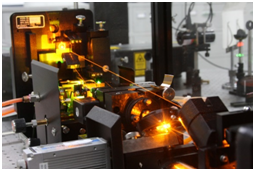
10. Ultrafast-Photonics Laboratory
RESEARCH FIELDS
General Research Direction:
Ultrafast Photonics and Optics, Nonlinear Optics with Weak Light
Current Topics:
Mesoscopic optics.
Quantum-optical coherence and nonlinear optics at low light intensities.
Nonlinear photonic materials at low light intensities.
Interaction of femtosecond laser pulses with photonic microstructures and its applications.
Phonon polaritons.
Ultrafast imaging in physics and biology.
Ultrafast dynamics in crystals, biomedical materials, quantum wells and quantum dot.
Spectroscopic measurement techniques
EQUIPMENT
Fs laser system; Time-resolved fluorescence spectroscopy; Transient absorption spectroscopy; Ar+ Laser; Detection system for weak light.
